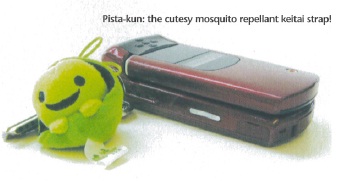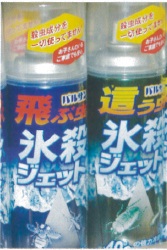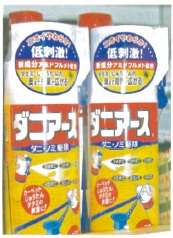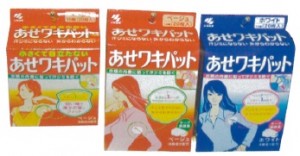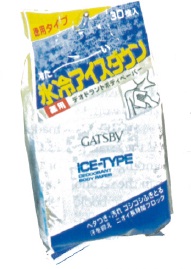Tips and Tricks for Keeping Cool this Summer
by Danielle Tate-Stratton
As we move past rainy season and well into the heat of the summer, it can be challenging enough to keep ourselves cool and calm without having to contend with the other side-effects of summer—creepy crawlies and health dangers among them. Of course, there are lots of tips and products to help you beat the heat, or at the very least survive it—read on for a few of our favorites.
Just How Hot Does it Get?
Tokyo’s average summer temperature is around 25°C in July, and 27°C in August (77-80°F). While hot, these aren’t temperatures to make your friends from, say, Arizona feel sorry for you, at least until you factor in the humidity. With levels of relative humidity (the amount of moisture in the air) reaching 90 percent and beyond, it can feel much hotter than it actually is. This is why weather forecasts often say the temperature is, for instance, 25°C (77°F), but that it feels like 35°C (95°F). This occurs because sweat doesn’t evaporate as quickly with so much moisture already in the air, slowing down one of our primary cooling responses. In general, most people feel comfortable at humidity levels of around 45 percent.
Of course, average temperatures are just that— average, and it can get much hotter. For instance, in 2004, the Adachi ward in Tokyo recorded a record high of 42.7°C (109°F) as well as 30 continuous days of temperatures over 30°C (86°F)!
Creepy Crawlies
Unfortunately, the heat and humidity of summer draws out lots of creepy crawlies! Most of them are just a bit unpleasant and inconvenient, but its always nice to know the best ways to banish them!
Mosquitos
While we may not appreciate the high humidity of summer, mossies love it and consequently thrive, annoying us with red and itchy bites. Prevent mosquitoes from breeding around your home by making sure you remove any sources of standing water and protect yourself with anti-mosquito products.
There are several types of sprays available in Japan, including Ihmen, which was Japan’s first pharmaceutical mosquito spray as of 2001. What classifies it as pharmaceutical is the inclusion of DEET in the ingredients list. DEET (Meta-N,N-diethyl toluamide) is believed to help stop insect bites by blocking the ‘receptors’ that insects, including mosquitoes, horseflies, and gnats, use to find things to bite.
For an incredibly kawaii and ‘only in Japan’ insect repellant, pick up a Pista-kun or two. Pista-kun is “a Pistachio Nut, cell phone strap, and stuffed toy with mosquito repellent power!” The small stuffed nut is soaked in natural blue gum oil and is said to repel mosquitoes for about a month. Order one from Strapya (www.strapya-world.com) for just ¥525.
Satisfy your hunting instincts with Varsan Hyosatsu Jet Spray for Flying Bugs, which sprays a stream of -40°C air, freezing flying bugs on contact (they also make a ‘creeping’ version for land-based bugs). The jet-spray doesn’t contain any pesticide chemicals so it doesn’t smell and it’s safe to use around the little ones.
Cockroaches
Everybody hates cockroaches, the hardy little (or not so little, unfortunately!) insects, which come out around this time and thrive in the humidity. Roaches are not only a health risk, potentially transferring salmonella and other unpleasant diseases, but are also guaranteed to make even the most practical of people squirm— their hard, shiny exoskeleton gives them a slimy appearance and they are much too big to pretend you never saw it!
Unfortunately, they are incredibly hardy as well— because of the way they breathe, cockroaches can actually survive after being beheaded, only dying once they starve to death. Knowing that is enough to give anyone the shivers! Luckily, people’s general dislike of these creatures has led to the discovery of lots and lots of ways to both prevent and eradicate these unpleasant critters. Sure you can get sprays and professional bug ‘bombs’, but here are a few more unusual things to try:
• An open bottle of tea tree or eucalyptus oil is an effective repellant.
• Cedar, Japanese mint, scotch spearmint, and bay leaves are good natural repellents.
• Close your windows and doors, turn on your heaters, and get out of the house—if you can get the temperature up to 50°C for three hours, you stand a good chance of killing the roaches. (Pity the person who has to go in the house to turn the AC back on!)
• Put out a bowl of dry cement or plaster of Paris near where roaches go, beside a bowl of water. They are attracted to the cement and plaster, and once they drink water to go with it, they harden from the inside out.
Tatami Bugs
Unique to living in Japan, tatami bugs (dani or ダニ in Japanese) are small creatures that infest, as their name suggests, tatami mats. You’ll know you have them when you wake up covered in small, red, itchy bites. The best way to get rid of them is to use a pesticide designed for this purpose, which will come with a long needle-like end. Poke the needle through the corners of your tatami and spray, killing the bugs living underneath. Repeat every six to eight weeks.
Keeping Healthy in the Heat
Watch out for heat exhaustion, which, according to webMD (www.webmd.com), is a milder (than heat stroke) yet still serious variation of hyperthermia, or increased body temperature. (Heat stroke occurs when body temperature reaches 106F.) Heat exhaustion is most common in people working or exercising outside in high heat, those with high blood pressure, or the elderly. Symptoms of heat exhaustion can include heavy sweating, paleness, nausea or vomiting, tiredness, or weakness. If you experience serious symptoms, have heart disease or high blood pressure, contact a doctor, but for very mild cases, resting, taking a cool shower, bath, or sponge bath, or drinking cool, nonalcoholic beverages, as directed by a physician, can all help lower your body temperature.
Another summer danger is dehydration, or the excess loss of fluids from the body. We all hear the ‘eight glasses of water a day’ mantra, but as hard as it can be to reach that goal, it gets even harder in the hot, humid summers when our fluid requirements rise. Dehydration is the result of not taking in enough fluid to replace what is lost. Symptoms of dehydration include: increasing thirst (many experts say that if you feel thirsty you are already dehydrated), dry mouth, weakness or lightheadedness, darkening of the urine, or a decrease in urination.
The best method of treating dehydration is to prevent it by drinking lots of water and other non-alcoholic, non-caffeinated beverages. If you do drink alcohol or caffeinated beverages, try and drink a glass of water for every glass of those drinks that you consume. If you are outside in the heat, consider adding an energy drink such as Pocari Sweat or Aquarius, which contain sodium and potassium. This helps to replace salts lost through sweating.
Children can be harshly affected by dehydration, and can have different symptoms such as not having tears when they cry. If you suspect your child may be dehydrated, or if you have moderate to serious symptoms, it is always best to contact your physician.
Best Clothes for Keeping Cool
There’s a good reason why traditionally Japanese women switched to wearing yukata in the summer—cotton is one of the best fabrics for beating the heat—it wicks sweat away from your body and allows your skin to breathe. Yukata are also great because their design allows for airflow, but even western-style cotton clothing will help you stay cool.
Remember to wear lighter colored clothing when possible, as those colors reflect the sun’s heat whereas darker colors absorb light much more effectively. Because in this case, (sun)light=heat, darker clothes trap heat and keep it close to your body.
To protect your clothing from those dreaded but all too common sweat marks, consider picking up a package of ‘ase waki patto‘, sticky papers you can attach to your clothing to protect them from those embarrassing underarm marks.
For a high-tech way to keep cool and protect yourself from the sun’s harmful rays, consider picking up some UV-protected clothing. Solartex Sungear (www.solartex.com) sells a variety of clothing with an SPF factor of 50 built in and has items ranging from swimwear to polo shirts to hats and accessories for the whole family. Some clothing items boast a protection rate of 98 percent, the highest amount possible. Solartex ships internationally, so you can get it here in Japan.
Keeping Yourself Cool
There are lots of great tricks for keeping yourself cool in the summer—try cool showers and baths, or if you don’t have time for that, run cool water over a pulse point or immerse your feet in cold water. At night, it can be very hard to sleep if your body temperature is elevated; to alleviate this, wet a facecloth with water and put it on your stomach—the cool cloth is very effective at lowering the temperature of your entire body. Use cotton sheets and sleepwear, just as during the day, and if you really need to cool down, consider a ‘chillow’, a simple insert which chills your pillow and means you won’t have to keep flipping it around looking for the cool spot. (There are also pet-bed versions.) Get one internationally shipped to Japan from tinyurl.com/yqys8q.
Utilize fans in rooms without air conditioning—air moving at speeds of as little as one mph can make it feel as much as a few degrees Fahrenheit cooler—crank up a fan and you can make your room feel like it’s April again! Another time to use a fan is when cooking, which you should avoid during the day, if possible—be sure to use an extractor fan if you have one in order to draw the extra heat out of your house.
For a quick pick-me-up when you do, inevitably, get bedraggled as a result of the heat, try Gastby Ice-Type Deodorant Body Paper, which not only deodorizes but contains ingredients designed to create a long-lasting cooling sensation as well.
Finally, when you really need a concentrated blast of cold air and can’t find a suitable building in time, try out another ‘only in Japan’ product—aircon in a can, which, as it sounds, produces a powerful spray of cold air; -40°C to be exact, which instantly provides relief from the heat. Be careful not to spray it directly onto skin as you can be just as painfully burnt from extreme cold as from heat. Learn more at www.strapya-world.com.


